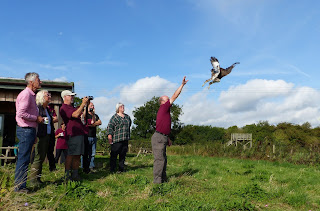2016: What a year - starting with one of the biggest January floods and finishing with one of
the driest Decembers on record. By the middle of February the water was (very
slowly), starting to recede, allowing us, and our new team of eager volunteers
to start work on repairing the path and hide at North Duffield Carrs. The work
at NDC kept the team busy throughout March and into April, when we then
switched to weed wiping the floodbanks, transforming the base wildlife garden
and giving a helping hand at Pillmoor and Plumpton Rocks. The first breeding
bird surveys and butterfly transects began, and moth trapping resumed at the
NNR base. DEFRA and Ad Astra also lent a hand on Skipwith Common, helping to
make wildlife corridors from recently cut birch scrub. The first order of the
LDV blank greetings cards arrived and the first talk of the year took place to
the River Waveney Trust in Suffolk.
Flooded out at NDC
Flood repairs underway
Nick & Sandra preparing the garden
Fence repairs on the Common
Successful day working with DEFRA
Ad Astra youth group get stuck in
New LDV greetings cards
Moth trapping resumes
During May a start was made on the resurrection of the
Escrick Duck Decoy and the last of the flood repair jobs were carried out,
along with the construction of several wood sheds at the NNR base to store our
newly cut timber. A start was also made building many Swift boxes in
conjunction with a new project involving the local communities and schools, and
a helping hand was given by insurance company Aviva. Several visits were made
to the local heronry with a pleasing number of chicks reared, and the
successful transportation of geese from York University was undertaken. For the
majority of June and July, pulling ragwort across the Ings meadows took
priority, along with fitting in the start of our nest box checks and our annual
goose round-up. Several (incredibly hot) days were also spent at Wheldrake
clearing scrub from around the pool, and carrying out repairs to the swan pipe in
preparation for the autumn. In July several of our staff and volunteers
attended the ‘Graftas’ award ceremony at the London Wetlands Centre – after
being nominated for and winning ‘volunteer group of the year’.
Progress in the duck decoy
New wood shed under construction
Corporate work day with Aviva
Successful Swift visit to Wheldrake school
Heron chick
Geese release
Hand pulling Marsh Ragwort
Aviva return
August and September were largely spent at Thornton Ellers,
making green hay and transporting it to sites in the surrounding area such as
Leven Carrs and Skerne YWT reserve, with a number of days also spent at
Wheldrake Ings removing and burning willows, and strimming the island
vegetation at NDC. Our tractor also came out of hibernation, with flailing
undertaken at Bank Island, Wheldrake, NDC and along the river bank. Jean came in to help out on what was a very popular and successful open day, and released yet another raptor back into the wild - a Common Buzzard, pictured here at the NNR Base. and A helping
hand was also given at Hornsea Mere, helping to clear scrub from the island.
The annual cygnet ringing took place at NDC, along with the last Barn Owls
broods of the year ringed. We also had the good fortunate of several corporate
work days with Aviva, Nestle and Amey.
Spreading the green hay
Tending to the path at NDC
Habitat management
Flailing at Wheldrake
Release of a Common Buzzard
Open Day success
Road trip to Hornsea Mere
Corporate work day with Amey
In October the flailing was finished before the site began
to ‘wet up’, and our attentions were switched back to the duck decoy, along
with many a day spent clearing scrub at North Duffield Carrs. The yearly task
of spraying pirri-pirri on Skipwith Common also began, along with the design
and arrival of the new 2017 LDV calendar. The autumn was also spent visiting
bird, gardening and walking clubs across the county with talks given by our
Senior Reserve Manager. During November days were spent on Skipwith Common NNR
clearing out the Pillwort ponds and removing birch scrub from the heath, a job
which carried on throughout most of December – just as the valley started to
flood. A day was spent at Jean's dismantling her old aviaries, the hide at the duck decoy was finished and the last gull catch of 2016 was had. That’s the year in a (very small) nutshell! Much more went on but it
just wouldn’t be possible to list it all on here! Many thanks to all those
involved in the valley during 2016, everything we achieved wouldn’t have been
possible without all the extra help that our dedicated volunteers give us each
week. Here’s to 2017!

Sandra loading up the mule
Cameron spraying on Skipwith
Finishing touches to the decoy hide
Dismantling Jean's aviaries
Opening up the Pillwort ponds
Gull catch at Rufforth Tip
Splitting timber - for sale
Nick removing birch on the Common
















































